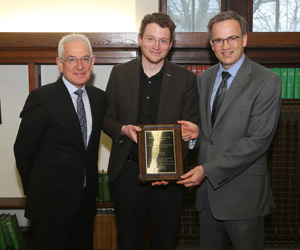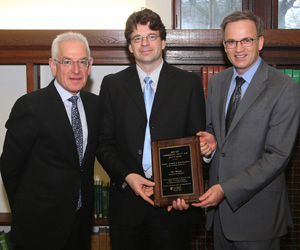At a large, complex research university like AVĺ„ņ÷≤Ņ, health and safety are paramount. Whether it‚Äôs in the lab, on the construction site or simply walking through the hallways, it‚Äôs crucial that the working environment remains a safe one for faculty, staff and students.
Each year, AVĺ„ņ÷≤Ņ‚Äôs Environmental Health and Safety Committee recognizes significant accomplishments in campus health and safety with AVĺ„ņ÷≤Ņ's Environmental Health and Safety Award. It's presented to individuals or groups who have undertaken activities that a) make Dal a safer place to live, play, work or study; b) improve safety for university activities off-campus; and/or c) integrate health and safety into teaching or research activities.
This years awards recognized individuals who took leadership roles in three different projects: a medical surveillance program in the Faculty of Medicine; contractor oversight in Facilities Management; and ongoing safety protocols and procedures in the Department of Chemistry.
 Dr. Gerald Johnston, Faculty of Medicine
Dr. Gerald Johnston, Faculty of Medicine
In 2009, the federal government passed the Human Pathogens & Toxins act, which wrote into law several responsibilities for institutions and organizations that use human pathogens in their work. One of these responsibilities is to have a medical surveillance program for individuals working with biological agents.
‚ÄúIt‚Äôs assessing the hazards that a researcher may be working with ‚ÄĒ like bacterial cells or infected tissues ‚ÄĒ and then outlining any medical inventions that might be appropriate,‚ÄĚ explains Dr. Gerald Johnston, associate dean of research in the Faculty of Medicine. ‚ÄúFor example, there may be a certain type of precautionary vaccination that‚Äôs required... It‚Äôs something we should do anyway, so it was a matter of ensuring our program aligned with the legal requirements.‚ÄĚ
Őż
The project involved recruiting a physician with medical surveillance experience to serve as an arms-length expert, reviewing all research protocols in the Faculty in which biological agents are used, and then partnering with the IWK Health Centre to provide on-site services as needed. In terms of the program's success, Dr. Johnston is quick to credit to Pauline Jones, who was previously Dal’s radiation safety officer and most recently served as acting director of the Office of Environmental Health and Safety.
Őż
‚ÄúIt‚Äôs really her effort that set this up,‚ÄĚ he says, crediting her contacts across Canada with helping line up the right people to support the surveillance program during her work on it. ‚ÄúShe was the force here, and deserves most of the credit.‚ÄĚ
 Ian Wagschal, Facilities Management
Ian Wagschal, Facilities Management
At any given time, there are dozens, maybe hundreds, of external contractors working on campus ‚ÄĒ at construction sites, on renovation projects and more. When Ian Wagschal returned to AVĺ„ņ÷≤Ņ to become assistant director of minor projects for Facilities Management ‚ÄĒ he was previously an architectural technician here ‚ÄĒ he saw an opportunity to improve Dal‚Äôs oversight of this work.
‚ÄúWe, as a university, are responsible for the safety of everyone who walks through these doors,‚ÄĚ he explains. ‚ÄúSo when contractors come in, we need to make sure the environment they‚Äôre working in is safe, and that they‚Äôre doing their part to protect the safety of our community.‚ÄĚ
In fall 2010, he played a lead role in bringing together representatives from Facilities Management, the Safety Office, the Procurement Office and Dal’s Legal Counsel to create a new system of contractor oversight. It involves unannounced site checks by the Safety Office to document unsafe work practices, after which the information can be shared either in formal incident reports or with Procurement to flag organizations whose practices could be detrimental to the university.
To date, more than 30 informal spot inspections have been carried out.
‚ÄúInstead of being somewhat blind, we have much better eyes on what flows through our doors,‚ÄĚ says Wagschal. ‚ÄúWe know when things aren‚Äôt up to our standards and we have ways by which we can address it.‚ÄĚ
 Mark Obrovac, Department of Chemistry
Mark Obrovac, Department of Chemistry
Given the size of the department and nature of the field, the Safety Committee plays a crucial role in the Department of Chemistry. Mark Obrovac, the committee’s current chair, arrived at Dal just as the previous chair was set to retire and, given his industry experience at 3M, he was a natural choice to take over the role.
In his role as chair of the eight-person committee, Dr. Obrovac has helped unify practices within the department, beginning with a revamp of lab audit procedures. The committee’s most significant work, though, has been in streamlining and harmonizing its policies to better align with the university as a whole.
‚ÄúIt was about taking what we already had here, in terms of lab audits and hazard reviews, and then working with the Safety Office to harmonize them,‚ÄĚ explains Dr. Obrovac, who is an NSERC/3M Canada Industrial Research Chair.
‚ÄúWe enhanced our auditing here, but also some of the things we‚Äôd been doing have now contributed to university policy. So it‚Äôs about sharing in both directions.‚ÄĚ
He’s quick to share the award with his entire team, and says he’s greatly enjoyed his experience on the committee (and plans to keep at it for the foreseeable future).
‚ÄúI learn a lot and find it interesting,‚ÄĚ he says.
Learn more about the .

